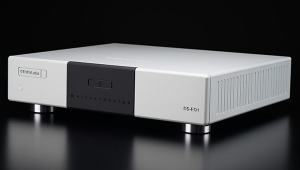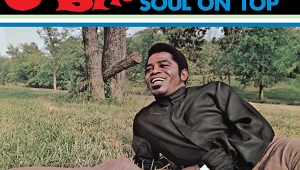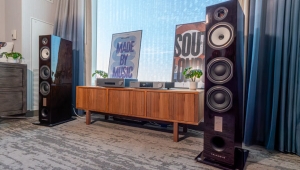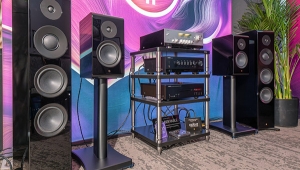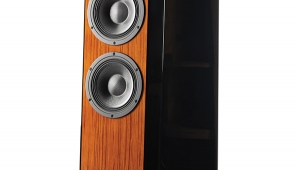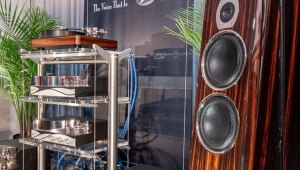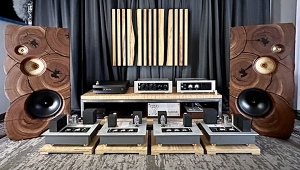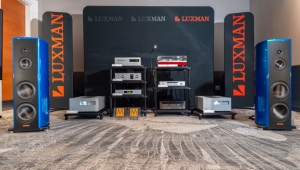| Columns Retired Columns & Blogs |
Spin Doctor #10: Tone Controls, Vinyl EQ Curves, and the Mola Mola Lupe

Twice in the last month I have been at someone's house, servicing their turntable, when they asked whether they should be considering a new phono preamp that offers additional playback equalization curves besides the standard RIAA. My usual reaction is to thumb through their record collection, where, more often than not, I find that they don't own a single record that was cut using a curve other than RIAA.
Footnote 1: The wavelength of a soundwave at 100Hz, at room temperature, is just over 11'.
Phono playback EQ is one of those audiophile topics that stokes some people's passions, with plenty of disagreements about how important it is. I have seen grown men get into heated discussions about the history of record EQ curves, but in truth, the subject is only likely to matter if you listen to a lot of 78s or original mono LPs pressed between the late 1940s and the mid-1950s.
Going well back into the pre–World War II 78 era, the engineers who designed record-playing systems realized that there could be two big benefits to applying some equalization to the signal before it reached the cutter head that creates the lacquer master disc. The reasons are complicated. For one thing, the energy in music peaks in the 50–100Hz range, depending on genre, and declines at higher frequencies. For another, loudspeaker drivers couple to the air less efficiently when the wavelength of the waves they're producing exceeds the transducer side by a lot (footnote 1). Finally, a vinyl-record cutter head, with an electrical signal that is flat with frequency, results in a groove size that declines with frequency at a rate of 6dB/octave (see sidebar).
The result is that when you are cutting the squiggly grooves for a record, bass energy results in big, wide swings of the groove while high-frequency sounds produce microscopically tiny deflections. Using equalization to reduce the bass level before it reaches the cutter head allows you to make grooves that are narrower and more tightly packed, lengthening the maximum playing time of the music that can be recorded on a record side. The amount of bass cut used is pretty substantial, about 20dB, which is kind of like turning the bass knob on a 1970s receiver all the way down to the minimum.
At the other end of the spectrum, they used the opposite approach, to reduce the audibility of surface noise and crackles by cranking up the high frequencies while cutting the record then turning them down again during playback. As with the bass cut, the treble boost is about 20dB, meaning that if you were to listen to the signal as it was being sent to the cutter head, there would be a 40dB tilt in the frequency response, making the sound incredibly thin and bright with no real bass to speak of.

RIAA recording (dotted blue) and playback curves (red). When these filters are applied sequentially, the result is exactly flat. If different recording and playback curves are used, the result is a coloration in the sound.
The playback EQ curve built into your phono preamp applies the equalization in reverse, adding 20dB of bass boost while cutting the treble by 20dB, thereby returning the sound balance to its original flat frequency response. When people talk about using different playback EQ curves, they are describing relatively small adjustments to this curve, varying the amount of frequency boosting and cutting being used, along with small shifts to the precise frequencies at which the boost and cut take effect.
When the LP was launched in 1948, several different equalization standards were still around; each record label decided for itself whether to follow one of the existing standards or to create their own. To make matters worse, a lot of labels were not forthcoming about which curve they were using, making it a bit of a guessing game for phonophiles to find the right one.
It was a big mess, but in 1953, RCA Victor proposed what they called the New Orthophonic Curve as a universal standard and encouraged the other record labels to adopt it. It had the advantage of being very similar to several other widely used curves. Within about three years, several standards organizations worldwide had adopted this curve, assigning it various names, and most of the world's record labels had settled on it. Eventually, they started to refer to the new standard by a less commercially linked name: the RIAA Curve.
While some people argue passionately that a handful of labels, especially in Europe and Asia, continued to use their own curves well into the 1960s, many of the mastering engineers making records at the time emphatically deny these claims. Which is where the heated arguments begin, with some people insisting that certain labels were still using their own non-standard curves well into the 1970s, or even the '80s. Sadly, many of the mastering engineers from that era are no longer with us to answer more questions.
To sum up the subject, several points should be made. First, while sonically significant, the differences in these curves aren't huge, so if you apply the wrong curve, you're still in the ballpark of what the engineers intended. Second, just because a record made in the '60s or '70s sounds better to you or me using a curve other than RIAA, that doesn't mean it's the intended curve.
Third, who knows what monitoring equipment those engineers were using? Even with the same curve, what they heard and what you're hearing could be quite different.
At the end of the day, these curves are tone controls, and it's fair game to prefer one setting over another even if it's not what the engineer intended back in 1962. It's nice to have choices.

The Mola Mola Lupe Phono Preamplifier
When Mola Mola first demonstrated a prototype of their Lupe phono preamp at the 2022 Munich High End show, I heard it had a whopping 72 equalization settings. I naturally assumed this was due to the wonders of digital signal processing; after all, the Dutch manufacturer (footnote 2) was best known for class-D amplifiers and for its highly rated Tambaqui D/A processor, both designed by company co-founder and respected digital guru Bruno Putzeys. Flexing the company's well-established digital chops, the Lupe's astonishing range of adjustments and features would be relatively easy to implement.
They say you should never make assumptions, and that's true for the Lupe, because, as I soon learned, the Lupe's signal path is 100% un-messed-with analog. No DSP here.
Housed in the same half-width shoebox-shaped chassis as the Tambaqui, the Lupe also shares the Tambaqui's sculpted sinewave top cover, a bit of a Mola Mola design signature. The company says the curves help to prevent chassis resonances. They also discourage stacking—probably a good thing considering the high sensitivity of phono gain circuits to electrical interference from nearby components. The front panel is also curved and has four tiny pushbuttons corresponding to the Lupe's four presets, and a round window OLED display showing the current input and configuration.
Going around back, the Lupe is jam-packed with connectors, looking more like a typical line stage preamp than a simple phono stage. The Lupe has hookups for four tonearms, three using single-ended RCA jacks and one with balanced XLRs. Each of the three single-ended inputs has its own grounding post, so you won't be faced with the fiddly task of trying to tighten a single ground post with your third hand while holding two or three ground wire spades stacked up together in position. Outputs are also available as single-ended RCA and balanced XLR, which may be selected individually or together. Finally, there's a pair of low-voltage trigger input and output jacks, should you wish to use another component to power the Lupe on and off.

Note I referred to those four front panel buttons as presets; they are, in a sense, input selectors. I called them presets because each is completely configurable and can be assigned to receive its signal from any of the four tonearm connections. For example, if you have a tonearm with four interchangeable headshells, each with a different cartridge, you could assign that arm's input to the Lupe to all four presets, then adjust each preset's gain and loading to suit the different cartridges. Or, using the same arm and cartridge, you could have four presets to match different records in your collection. Preset one could be for modern stereo records, preset two for your collection of early Columbia mono pressings with its own EQ setting and the mono switch engaged (yes, there's a mono switch), and preset three with settings for your original British Decca mono pressings.
To help you get a handle on all this flexibility, the Lupe has a downloadable app called Mola Mola Control, available for both iOS and Android. Once installed, the app talks directly to the Lupe over Bluetooth, providing access to all the Lupe's many adjustments. Even I, a boomer analog enthusiast with less-than-stellar IT skills, found the app commendably intuitive, making it simple to explore the Lupe's many functions.
When setting up a preset, you first select which of the four inputs you are using, and whether you want the output signal to go to the RCA or XLR outputs, or both. Then you pick either moving magnet or moving coil. Most phono preamps with both moving magnet and low-output moving coil inputs simply insert an additional gain stage or step-up transformer in front of the moving magnet stage when the moving coil input is used, but the Lupe has two entirely separate phono sections, one for each cartridge type. The basic gain and loading options are optimized for each type of cartridge, the moving coil input offering six resistive loading options ranging from 60 ohms to 1k ohms, and eight gain settings from 52dB all the way up to a whopping 87dB.
Footnote 1: The wavelength of a soundwave at 100Hz, at room temperature, is just over 11'.
Footnote 2: Mola Mola, Kattegat 89723, JP Groningen The Netherlands. Tel: +31 50 526 4993. Email: info@mola-mola.nl. Web: mola-mola.nl. US distributor: GTT Audio, Tel: (908) 850-3092 Email: av@gttaudio.com Web: gttaudio.com
- Log in or register to post comments
